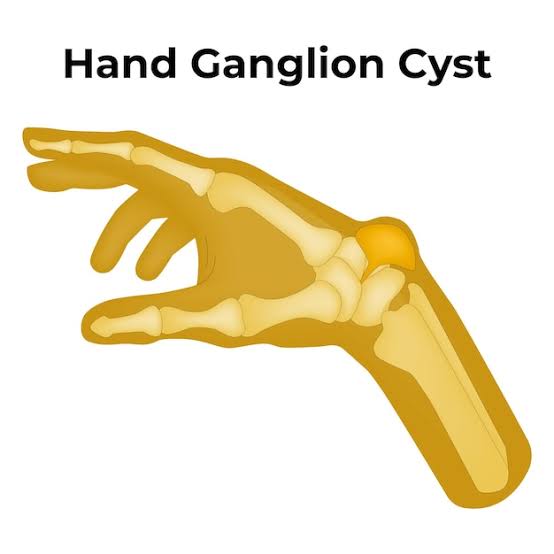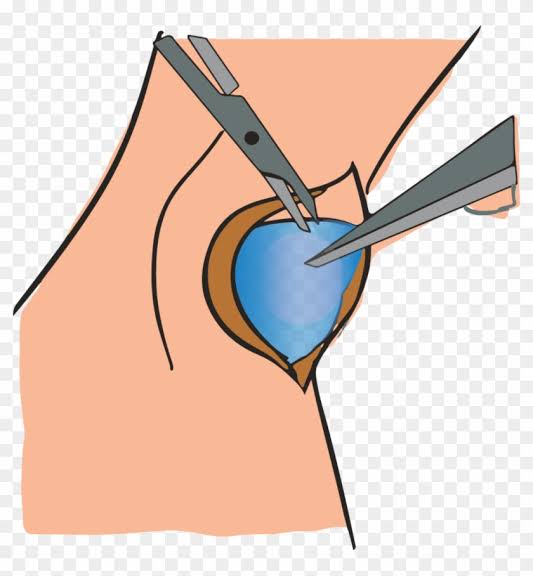A noncancerous lump surrounded by a thick, gel-like fluid is known as a ganglion cyst. Although they can also develop in other parts of the body, such as the ankles or feet, these cysts typically develop on the wrists, hands, and fingers. Ganglions are frequently regarded as a nuisance rather than a serious medical issue and rarely cause cancer.

Pathology of Ganglion Cysts
Ganglion cysts’ exact cause remains a mystery. However, the following factors are thought to contribute to their development:
1. Irritation of a Joint or Tendon: Ganglions frequently develop as a result of numerous minor injuries or irritations to a joint or tendon. As a protective measure for the affected area, the body’s response to this irritation may result in the formation of a cyst.
2. Synovial Fluid Accumulation: Ganglions are typically found in close proximity to tendons and joints. Synovial fluid, which lubricates and cushions these structures, may leak out and form a cyst, which could lead to their development.
3. Weakness in Connective Tissue: Some people may be more likely than others to get ganglion cysts because their connective tissue is weak.
Causes of Ganglion Cysts
As previously stated, joint and tendon irritation, synovial fluid accumulation, and connective tissue weakness are the most common causes of ganglion cysts. However, there are some things and activities that can make it more likely that a ganglion cyst will form. These are some of them:
1. Activities that Require Repetitive Joint Movements: Engaging in sports like tennis, typing, playing musical instruments, or other activities that require repetitive joint movements can raise the risk of ganglion cysts.
2. Age and Gender: People between the ages of 15 and 40 are more likely to develop ganglion cysts. Additionally, they frequently affect women more than men.
3. Previous Injuries: Ganglion cyst formation may be influenced by a history of minor joint or tendon injuries.
Risk Factors of Ganglion Cysts
Ganglion cysts can happen to anyone, but certain risk factors may make some people more likely to get them. Some of these risk factors are:
1. Genetics: An individual’s susceptibility to ganglion cysts may be influenced by their family history. You may be more likely to develop a ganglion cyst if a close family member has one.
2. Hazards at Work: Jobs that require you to use your hands or wrists repeatedly, like typing or using tools, can make you more likely to get ganglion cysts.
Signs and Symptoms of Ganglion Cysts
1. Visible Lump: Ganglions typically appear as small, round bumps beneath the skin. They typically feel firm and smooth to the touch.
2. Discomfort or Pain: Ganglion cysts can be painful or uncomfortable, especially if they press on nerves or make it hard for a joint to move. A dull ache is often used to describe the pain.
3. Size Variations: Ganglion cysts’ sizes can fluctuate over time. They may grow or shrink, or even temporarily vanish.
4. Stiffness: Difficulty using the affected limb or joint can result from restricted joint movement caused by ganglion cysts in some instances.
Investigating Ganglion Cysts
A series of tests may be performed to confirm the diagnosis and determine the cyst’s severity if you have been given the go-ahead to see a medical professional or have been given the impression that you have a ganglion cyst. Among these investigations are:
1. Physical Exam: Your doctor will start by doing a thorough physical exam to see how big the cyst is, where it is, and how painful it is. Additionally, they will assess your range of motion and joint function.
2. Imaging Tests: In some cases, your doctor may order imaging tests like ultrasound, magnetic resonance imaging (MRI), or X-rays to get a better look at the cyst and how it relates to the structures around it.
3. Fine-Needle Aspiration: Your healthcare provider may perform a fine-needle aspiration to confirm the diagnosis. A small needle is used to take a sample of the cyst’s fluid for analysis during this procedure. Additionally, this may assist in excluding other potential causes.
4. Biopsy: A biopsy may be suggested in rare circumstances where the diagnosis is still uncertain. A small amount of the cyst’s tissue is taken for analysis in the laboratory.
How Homeopathy Works for Ganglion Cysts
1. Calcarea Fluorica: Useful for ganglion cysts at the back of the wrist or finger joints that are hard and stony, especially if they get worse when you rest or the weather changes. Heat and warm applications may provide relief.
2. Ruta Graveolens: It is suggested for ganglion cysts on the wrist near tendons that cause pain in hand and wrist stiffness.
3. Benzoicum Acidum: indicated for great tearing pain and wrist swelling caused by ganglion cysts. When exposed or in the open, symptoms may get worse.
4. Rhus Toxicodendron: Helpful for pain in the palm of the hand and ganglion cysts that make it hard to move the wrist. Rest provides relief, while motion aggravates the condition.
5. Silicea Terra: Suitable for wrist discomfort, tearing, stitching pain, and painful soft ganglion cysts. During certain lunar phases, in the morning, and in cold, wet, or humid weather, symptoms may get worse. Warmth and covering provide relief.
6. Bryonia: For painful ganglion cysts, especially when moving.

Conclusion: Empowering Choices
You should discuss your specific symptoms, preferences, and overall health with a medical professional before selecting a treatment for ganglion cysts. The goal is to find a solution that meets your needs and improves your health, whether you choose conventional medicine, homeopathy, or a combination of the two.
Reach out to us for a Consultation
For any queries, reach out to us at contact@homeopathic.ai
This blog is for information purposes. It’s crucial to note that while homeopathy is a centuries-old practice with many adherents worldwide, always consult a qualified homeopath or medical professional before initiating any treatment.





